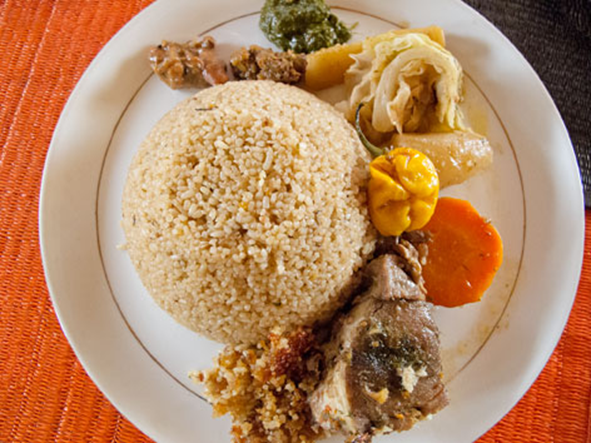Senegal, located on the western coast of Africa, is known for its vibrant culture, rich history, and diverse cuisine. Among the array of mouthwatering dishes that the country offers, one stands out for its exquisite flavors and cultural significance – Ceebu Jën. Ceebu Jën, which translates to “rice and fish” in Wolof, is a traditional Senegalese dish that combines fragrant rice, succulent fish, and an array of vegetables and spices. This article will delve into the origins of Ceebu Jën, its preparation process, and the delightful flavors that make it a favorite among Senegalese locals and visitors alike.
Ceebu Jën is deeply rooted in Senegalese culture and has become a symbolic dish of national pride. It is often prepared for special occasions, religious festivals, and family gatherings, serving as a centerpiece that brings people together. The dish is a reflection of Senegal’s coastal location, with an abundance of fresh fish and a fusion of flavors influenced by the country’s diverse ethnic groups.
The preparation of Ceebu Jën is a labor of love that involves careful attention to detail. The dish typically starts with a flavorful broth made from simmering fish heads, bones, and aromatic vegetables such as onions, garlic, and parsley. This broth forms the base of the dish, infusing the rice with a depth of flavor. The fish used in Ceebu Jën is often a firm and meaty variety such as red snapper, grouper, or tilapia. The fish is seasoned with spices like thyme, paprika, and black pepper before being fried or grilled to perfection.
Once the fish is cooked, it is set aside, and the broth is strained and used to cook the rice. The rice is gently simmered in the flavorful liquid, absorbing the essence of the fish and vegetables. This results in a fragrant and beautifully colored rice that forms the foundation of Ceebu Jën. To further elevate the flavors, various vegetables such as carrots, cabbage, eggplant, and okra are added to the pot, infusing the dish with their natural sweetness and textures.
Ceebu Jën is a true celebration of flavor, and the final touch comes in the form of a spicy tomato sauce known as “dibi.” Dibi is made by sautéing onions, garlic, tomatoes, and a medley of spices, including chili pepper, cayenne, and thyme. The sauce is then poured over the fish, creating a tantalizing combination of heat, acidity, and savory notes.
The beauty of Ceebu Jën lies in the way it brings together different elements to create a harmonious whole. The tender, flaky fish contrasts with the aromatic rice, while the vibrant vegetables add color and texture. The interplay of spices and the heat of the dibi sauce create a flavorful symphony that dances on the taste buds.
Beyond its tantalizing taste, Ceebu Jën offers a nutritious meal packed with essential nutrients. The combination of fish and rice provides a balanced source of protein, carbohydrates, vitamins, and minerals. The vegetables add additional vitamins and dietary fiber, making Ceebu Jën a wholesome and satisfying dish.
For those fortunate enough to savor Ceebu Jën in Senegal or at a Senegalese restaurant elsewhere, it offers an immersive experience into the heart of Senegalese cuisine and culture. The communal nature of sharing a large platter of Ceebu Jën with family and friends embodies the spirit of togetherness and hospitality that Senegal is known for.
In conclusion, Ceebu Jën is more than just a dish; it is a representation of Senegal’s culinary heritage and the warmth of its people. From the fragrant rice to the succulent fish and vibrant vegetables, every bite tells a story of tradition and a passion for flavor. So, if you have the opportunity to try Ceebu Jën, embrace the savory taste of Senegal and embark on a culinary journey that will leave a lasting impression.








